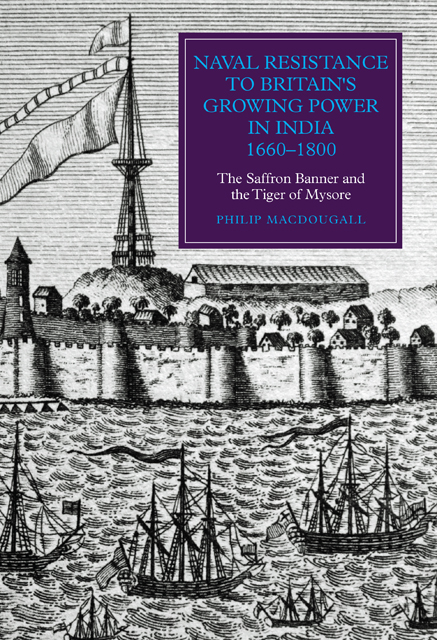 Naval Resistance to Britain's Growing Power in India, 1660–1800
Naval Resistance to Britain's Growing Power in India, 1660–1800 Published online by Cambridge University Press: 23 February 2023
The existence, during the late fifteenth century, of a powerful navy under the control of at least one indigenous Indian state would have created a very different scenario to the one played out upon the first arrival of the Portuguese and their subsequent monopolising of the spice trade. Furthermore, the updating and development of such a navy or navies would have ensured the continued independence of the sub-continent. That no such substantial navy existed in 1498 CE (903 AH) resulted in the three relatively insignificant ships brought to the shores of India by Vasco da Gama, paving the way for a European dominance of the coastal region and later the interior that was to span 450 years. Admittedly those three ships represented the pinnacle of technological development: hulls of great strength to meet the stress demands of a deep ocean voyage; square rigged for long down-wind passages; lower decks almost certainly pierced with gun ports and ordnance of bronze rather than iron. Yet in truth, there was little that a determined Indian state might not have been either aware of or able to replicate. Through trading links that stretched across the Indian Ocean and the Arabian Peninsula and then further on to the Ottoman Empire, the states of India could have been informed of the on-going technological developments taking place in Europe. In particular they would have learnt of the increasing use of artillery at sea. Yet no thirst for such information and the updating of naval technology at that time or for many previous decades actually existed.
In this section, initial concentration is upon that first contact with the Portuguese and the failure of various indigenous navies to defeat this first arriving European power through direct large-scale attacks on a main or subsidiary fleet. Unable to inflict significant damage on an enemy that was better trained, better armed and in possession of ships that were more resilient, attention turned to the development of alternative, irregular warfare tactics. However, in itself, the stalking and waylaying of isolated ships would not have met with the success it eventually achieved if it had not been for a number of additional developments. Among these, and of particular importance, was the employment by the indigenous naval states of knowledgeable Europeans whose impact was quite significant.
To save this book to your Kindle, first ensure no-reply@cambridge.org is added to your Approved Personal Document E-mail List under your Personal Document Settings on the Manage Your Content and Devices page of your Amazon account. Then enter the ‘name’ part of your Kindle email address below. Find out more about saving to your Kindle.
Note you can select to save to either the @free.kindle.com or @kindle.com variations. ‘@free.kindle.com’ emails are free but can only be saved to your device when it is connected to wi-fi. ‘@kindle.com’ emails can be delivered even when you are not connected to wi-fi, but note that service fees apply.
Find out more about the Kindle Personal Document Service.
To save content items to your account, please confirm that you agree to abide by our usage policies. If this is the first time you use this feature, you will be asked to authorise Cambridge Core to connect with your account. Find out more about saving content to Dropbox.
To save content items to your account, please confirm that you agree to abide by our usage policies. If this is the first time you use this feature, you will be asked to authorise Cambridge Core to connect with your account. Find out more about saving content to Google Drive.